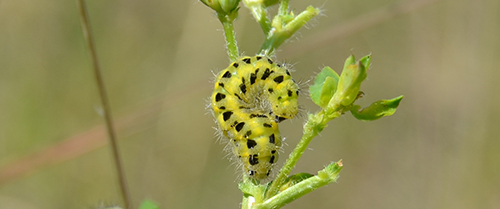PhD Defence by Stefan Pentzold
Title of defence: Insect counter-adaptions to plant cyanogenic glycosides
Supervisors:
Professor MSO Søren Bak
Professor Birger Lindberg Møller
Ass. Professor Mika Zagrobelny
Assessment committee:
Prof. Dr. Susanne Dobler (Molecular Evolutionary Biology, Zoological Institute, University of Hamburg)
Jun. Prof. Dr. Anke Steppuhn (Molecular Ecology, Dahlem Centre of Plant Sciences, Free University of Berlin)
Assoc. Prof. Adam Takos (Department of Plant and Environmental Sciences, University of Copenhagen)
The defence will be followed by a reception in LIFE-PLBIO K117 and H117. Everybody is welcome!
Abstract: Cyanogenic glucosides are ancient and widespread defence compounds that are used by plants to fend off non-adapted insect herbivores. After insect herbivory and plant tissue damage, cyanogenic glucosides come into contact with compartmentalised plant β-glucosidases, resulting in the release of toxic hydrogen cyanide. Such a binary system of components that are chemically inert when separated is also referred to as two-component plant defence. Since the co-evolution of cyanogenic plants and insect herbivores has continued for several hundred million years, some specialised herbivores have adapted and gained the ability to feed on cyanogenic plants. Moreover, a few specialists are even able to sequester cyanogenic glucosides into specialised tissues, often for use in their own defence. However, insect counter-adaptations to overcome plant cyanogenic glucosides are largely unknown.
This thesis presents evidence that larvae of the sequestering lepidopteran specialist Zygaena filipendulae have evolved diverse behavioural, morphological, physiological and metabolic adaptations to keep cyanogenic glucosides from its food plant Lotus corniculatus (Fabaceae) intact and thus non-toxic during feeding and digestion [1]. These adaptations are a prerequisite to sequester intact cyanogenic glucosides quickly from the gut into the haemolymph and other larval tissues [2]. Finally, cyanogenic glucosides deposited in defence droplets are used in the insect’s own defence either due to the bitter taste of intact cyanogenic glucosides or in combination with stickiness. In the case of severe damage, causing integument rupture, defence droplets release high amounts of hydrogen cyanide, because they mix with exuding haemolymph containing β-glucosidases. Moreover, the generalist lepidopteran Spodoptera littoralis was shown to have similar adaptations to overcome cyanogenic glucosides as reported from Z. filipendulae. Thus, lepidopterans as well as some herbivorous species from other insect orders, including generalists and specialists, seem relatively well-adapted to cyanogenic glucosides and various other classes of two-component plant chemical defence [3].
The results obtained in this thesis provide unique insights into the co-evolution and adaptation of insect herbivores to cyanogenic plants. It raises several research questions regarding herbivory of cyanogenic plants that need to be examined in more detail, and offer observations which could be extrapolated to other two-component plant-insect defence systems.
Publications:
[1] Pentzold, S., Zagrobelny, M., Roelsgaard, P. S., Møller, B. L. & Bak, S. (2014). The multiple strategies of an insect herbivore to overcome plant cyanogenic glucoside defence. PLoS ONE 9, e91337.
[2] Zagrobelny, M., Olsen, C. E., Pentzold, S., Fürstenberg-Hägg, J., Jørgensen, K., Bak, S., Møller, B. L. & Motawia, M. S. (2014). Sequestration, tissue distribution and developmental transmission of cyanogenic glucosides in a specialist insect herbivore. Insect Biochemistry and Molecular Biology 44, 44-53.
[3] Pentzold, S., Zagrobelny, M., Rook, F. & Bak, S. (2013). How insects overcome two-component plant chemical defence: plant β-glucosidases as the main target for herbivore adaptation. Biological Reviews doi: 10.1111/brv.12066.
